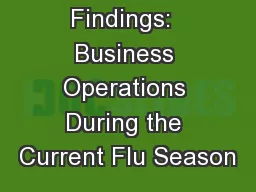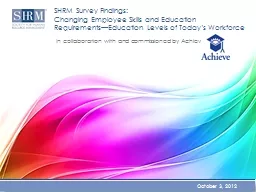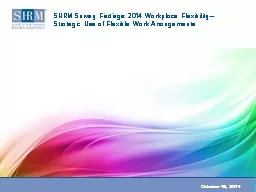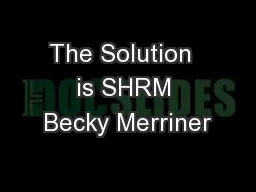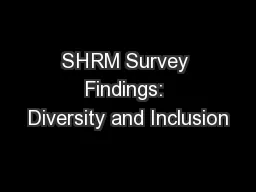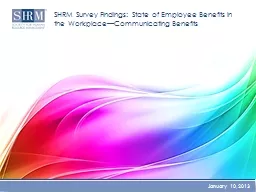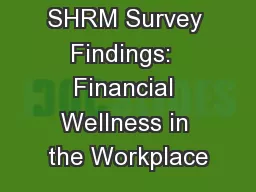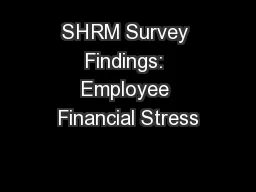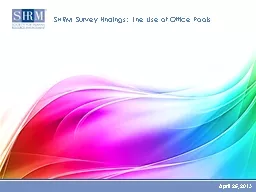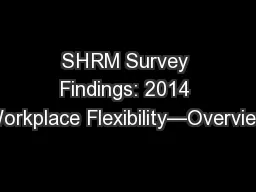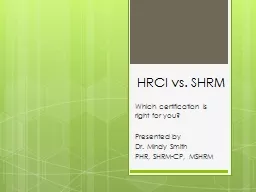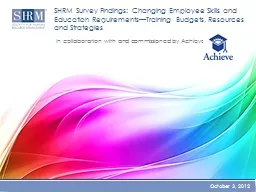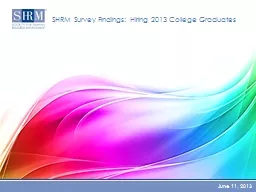PPT-SHRM Survey Findings: Workplace Romance
Author : karlyn-bohler | Published Date : 2020-01-26
SHRM Survey Findings Workplace Romance September 24 2013 How common is workplace romance One out of four 24 employees reported they have been or are currently involved
Presentation Embed Code
Download Presentation
Download Presentation The PPT/PDF document "SHRM Survey Findings: Workplace Romance" is the property of its rightful owner. Permission is granted to download and print the materials on this website for personal, non-commercial use only, and to display it on your personal computer provided you do not modify the materials and that you retain all copyright notices contained in the materials. By downloading content from our website, you accept the terms of this agreement.
SHRM Survey Findings: Workplace Romance: Transcript
SHRM Survey Findings Workplace Romance September 24 2013 How common is workplace romance One out of four 24 employees reported they have been or are currently involved in a workplace romance Fortythree percent of HR professionals. Hiring 2013 College Graduates. June 11, 2013. Definitions. For . this . survey,. “. 2013 . college . graduates”. . refers . to both 2013 college undergraduates, those with a four-year degree (e.g., B.S., B.A. degree) and 2013 college . February 13, . 2013. Key Findings. Business . Operations During the Current Flu . Season . ©SHRM . 2013. 2. Is the current flu epidemic having a negative impact . on . organizations’ overall . business . Employee Skills and Education . Requirements—Education Levels . of . Today’s Workforce. October 3, 2012. In collaboration. with and commissioned by Achieve. This is the second part of a series of SHRM/Achieve survey findings titled “Changing Employee Skills and Education Requirements. Use of Flexible Work . Arrangements. October 15, 2014. 2. Introduction and definition. Introduction. The 2014 Workplace Flexibility Survey was administered by the Society for Human Resource Management (SHRM) to identify the prevalence and types of flexible work arrangements (. Virginia Northern District Director. ©. SHRM . 2013 . WHY BE A MEMBER?. Keeping your HR skills and knowledge up to date may be the key to landing a new job or holding on to the one you have—SHRM can give you a competitive edge. April 8, 2014. Who is responsible for implementing and leading diversity initiatives in the workplace? . More than three-fifths (64%) of organizations reported that HR is responsible for . implementing. January 10, . 2013. This is part . six . of a series of SHRM surveys examining the state of employee benefits in the workplace. . The following topics are . included in . this . six-part . series:. Part 1: Wellness initiatives . Sponsored by McGraw-Hill Federal Credit Union. May . 14, . 2014. Definitions. Financial education: . Any workplace initiative, program or resource designed to provide employees with information on how to manage their resources effectively for a lifetime of financial well-being. . In collaboration with and commissioned by. June 25, 2014. How do HR professionals rate the overall financial health of their employees? . Roughly three-fifths (61%) of HR . professionals . consider their overall employees’ financial health to be . Use of Office . Pools. April 25, . 2013. Definition. In this survey, the term “office pools” refers to gambling in the workplace, including games, competitions or other events. Office pools can be linked to football games, the Super Bowl, the Oscars, the NCAA basketball championship . of Flexible Work . Arrangements. October 15, 2014. Introduction. The . 2014 Workplace Flexibility Survey was administered by the Society for Human Resource Management (SHRM) to identify the prevalence and types of . Presented by . Dr. Mindy Smith. PHR, SHRM-CP, MSHRM. History Lesson. Originally, Human Resources Certification Institute (HRCI) was the only governing body to administer exams. Now both HRCI and . Society for Human Resources Management (SHRM) . SHRM Survey Findings: Changing Employee Skills and Education Requirements—Training Budgets, Resources and Strategies October 3, 2012 In collaboration with and commissioned by Achieve This is the fourth part of a series of SHRM/Achieve survey findings titled “Changing Employee Skills and Education Requirements SHRM Survey Findings: Hiring 2013 College Graduates June 11, 2013 Definitions For this survey, “ 2013 college graduates” refers to both 2013 college undergraduates, those with a four-year degree (e.g., B.S., B.A. degree) and 2013 college
Download Rules Of Document
"SHRM Survey Findings: Workplace Romance"The content belongs to its owner. You may download and print it for personal use, without modification, and keep all copyright notices. By downloading, you agree to these terms.
Related Documents


